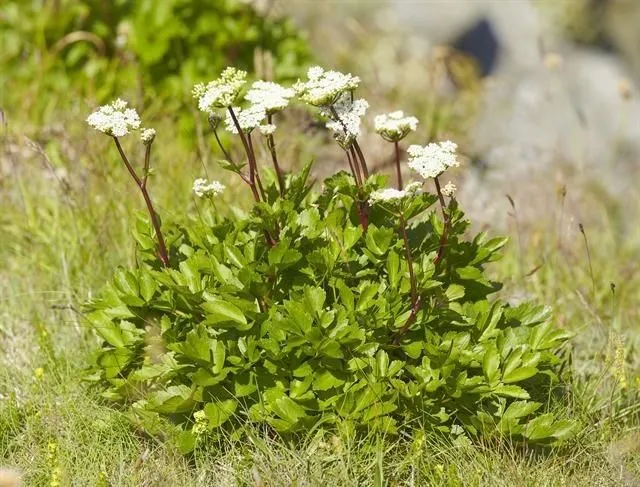
Author: L.
Bibliography: “Sp. pl. 1:250. 1753 “”scothicum“””
Year: Unknown
Status: accepted
Rank: species
Genus: Ligusticum
Vegetable: False
Observations: Unknown
Scots lovage, known scientifically as Ligusticum scoticum, is a captivating plant that belongs to the Apiaceae family. This species was first recorded in “Sp. pl. 1:250” in the year 1753 by the esteemed botanist Carl Linnaeus, commonly referred to by the abbreviation ‘L’.
Scots lovage typically thrives in coastal regions and can often be found in rocky shorelines and sea cliffs where it contributes to the unique biodiversity of these habitats. It is noted for its robust and aromatic foliage, which resembles that of celery with a hint of parsley, hinting at its close familial ties within the Apiaceae.
As a perennial herb, Ligusticum scoticum boasts a hardy nature. The plant features compound leaves with broad, toothed edges and produces clusters of small white to pinkish flowers. These blooms, which usually appear in the early summer, are arranged in umbels typical of the carrot family and play an essential role in attracting pollinators such as bees and butterflies.
Historically, Scots lovage has been used in traditional medicine and culinary practices among coastal communities. The leaves and stems were often employed to add a distinctive flavor to soups and broths, and in some cultures, it was believed to have beneficial health properties. However, detailed modern observations and research about its medicinal uses remain relatively unknown.
Given its preference for cool, moist environments, Scots lovage is well-adapted to withstand the salinity and harsh conditions of its seaside habitat. This resilience makes it a fascinating subject for studies on plant adaptation and survival in extreme environments.
In sum, Ligusticum scoticum or Scots lovage is a notable plant not only for its ecological value but also for its cultural and historical significance. Its enduring presence along coastal landscapes serves as a reminder of the intricate connections between flora and the environments they inhabit.
Nor: agurkurt, gåsefot, oksetunge, lubstilk, wild-løbstik, wild-løbstilk
Swe: gurkört, italiensk oxtunga, oxtunga, paddfot, rantaputki, strandloka, strandfloka, strandsticka
Dan: hjulkrone, italiensk oksetunge, læge-oksetunge, skotsk lostilk
Fin: purasruoho, rohtorasti, terhi, rantaputki
Eng: scots lovage, scottish licorice-root, beach lovage, scotch lovage, scot’s lovage, scotch licorice-root, scotch wild lovage, scottish licorice root, scottish lovage, sea parsley, sea lovage
Deu: schottische mutterwurz
Nob: strandkjeks
Nno: strandkjeks
Fra: livèche d’écosse, livèche écossaise, persil de mer
Cym: dulys, llwfach albanaidd, llwfach yr alban, persli’r meirch
En: Scots lovage, Beach lovage, Scottish licorice-root, Scot’s Lovage, Scotch Lovage, Scotch Licorice-root, Scotch wild lovage, Scottish Licorice Root, Scottish Lovage, Sea Parsley, Sea lovage
Zh: 苏格兰藁本
Da: Hjulkrone, Italiensk oksetunge, Læge-Oksetunge, Skotsk lostilk
Fj: Sikote lovage
Fi: Merirantaputki, Rantaputki, Purasruoho, Rohtorasti, Terhi
Fr: Livêche d’Écosse, Livèche d’Écosse, Livèche écossaise, Persil de mer
De: Schottische Mutterwurz, Schottischer Liebstöckel
Is: Sæhvönn
Ga: Sunais
No: Strandkjeks, Agurkurt, Gåsefot, Oksetunge, Lubstilk, Wild-løbstik, Wild-løbstilk
Nb: Strandkjeks
Nn: Strandkjeks
Sv: Strandloka, Gurkört, Italiensk oxtunga, Oxtunga, Paddfot, Rantaputki, Strandfloka, Strandsticka
Cy: Llwfach yr Alban, Dulys, Llwfach Albanaidd, Persli’r Meirch
Taken Jul 20, 2021 by Sergey (cc-by-sa)
Taken Jul 15, 2015 by Photoflora – Benoit BOCK (©)
Taken Jan 1, 1900 by EOL − Encyclopedia of Life (cc-by-nc)
Taken Jan 1, 1900 by EOL − Encyclopedia of Life (cc-by-nc)
Taken Jan 1, 1900 by EOL − Encyclopedia of Life (cc-by-nc)
Taken Aug 10, 2021 by ulrich stephinger (cc-by-sa)
Taken Aug 21, 2021 by Peter Andresen (cc-by-sa)
Taken Apr 16, 2022 by Andrzej Konstantynowicz (cc-by-sa)
Taken Jun 23, 2021 by Noémi Charest (cc-by-sa)
Taken May 31, 2022 by Jasper Willemsen (cc-by-sa)
Taken Jul 15, 2015 by Photoflora – Benoit BOCK (©)
Taken Jul 15, 2015 by Photoflora – Benoit BOCK (©)
Taken Jul 15, 2015 by Photoflora – Benoit BOCK (©)
Taken Apr 16, 2022 by Andrzej Konstantynowicz (cc-by-sa)
Taken Jul 6, 2022 by Bernt Bjørndal (cc-by-sa)
Taken Jul 20, 2021 by Sergey (cc-by-sa)
Taken Jul 28, 2021 by Deborah Welch (cc-by-sa)
Taken Jul 13, 2022 by elisr elise (cc-by-sa)
Taken Jan 28, 2014 by EOL − Susan Elliott (cc-by-nc)
Taken Jan 1, 1900 by EOL − Encyclopedia of Life (cc-by-nc)
Taken Jan 1, 1900 by EOL − Encyclopedia of Life (cc-by-nc)
Taken Jan 1, 1900 by EOL − Stemonitis (cc-by-sa)
Taken Jan 1, 1900 by EOL − Encyclopedia of Life (cc-by-nc)
Taken May 21, 2015 by EOL − Paul Norwood (cc-by-nc)
Taken Oct 2, 2022 by Joey F (cc-by-sa)
Growth habit: Forb/herb
Family: Myrtaceae Author: (F.Muell.) K.D.Hill & L.A.S.Johnson Bibliography: Telopea 6: 402 (1995) Year: 1995 Status:…
Family: Rubiaceae Author: Pierre ex A.Froehner Bibliography: Notizbl. Bot. Gart. Berlin-Dahlem 1: 237 (1897) Year:…
Family: Sapindaceae Author: Koidz. Bibliography: J. Coll. Sci. Imp. Univ. Tokyo 32(1): 38 (1911) Year:…
Family: Asteraceae Author: A.Gray Bibliography: Pacif. Railr. Rep.: 107 (1857) Year: 1857 Status: accepted Rank:…
Family: Fabaceae Author: Medik. Bibliography: Vorles. Churpfälz. Phys.-Ökon. Ges. 2: 398 (1787) Year: 1787 Status:…
Family: Aspleniaceae Author: (Cav.) Alston Bibliography: Bull. Misc. Inform. Kew 1932: 309 (1932) Year: 1932…